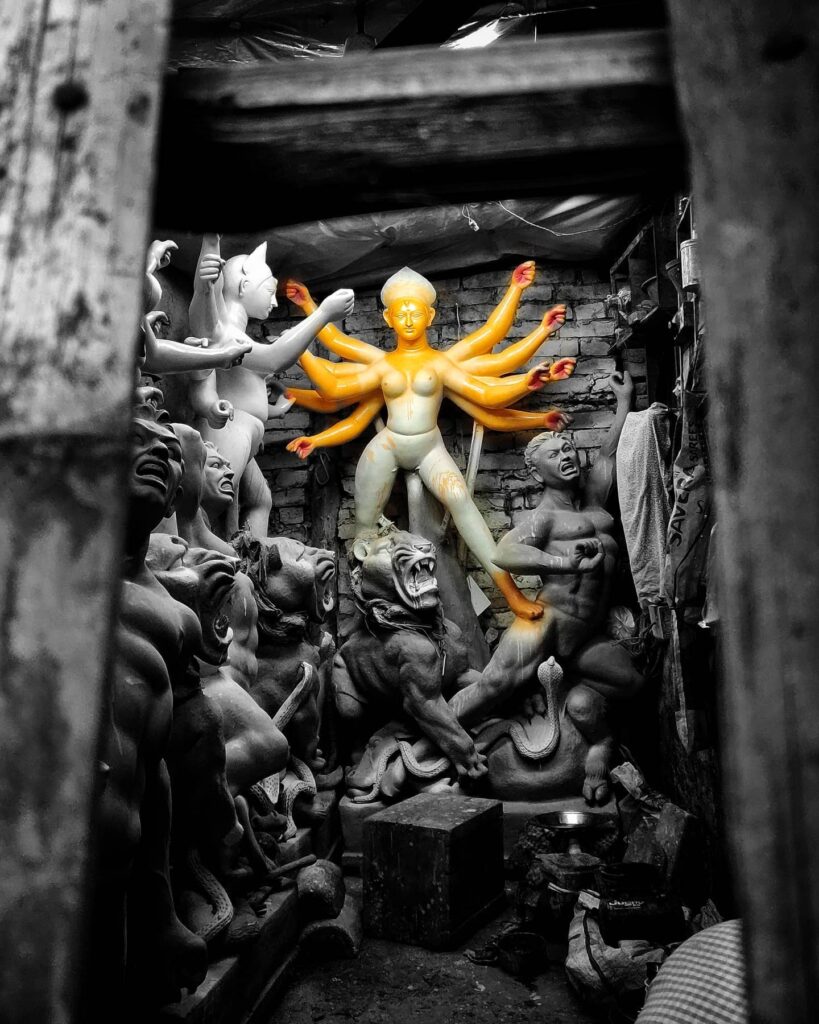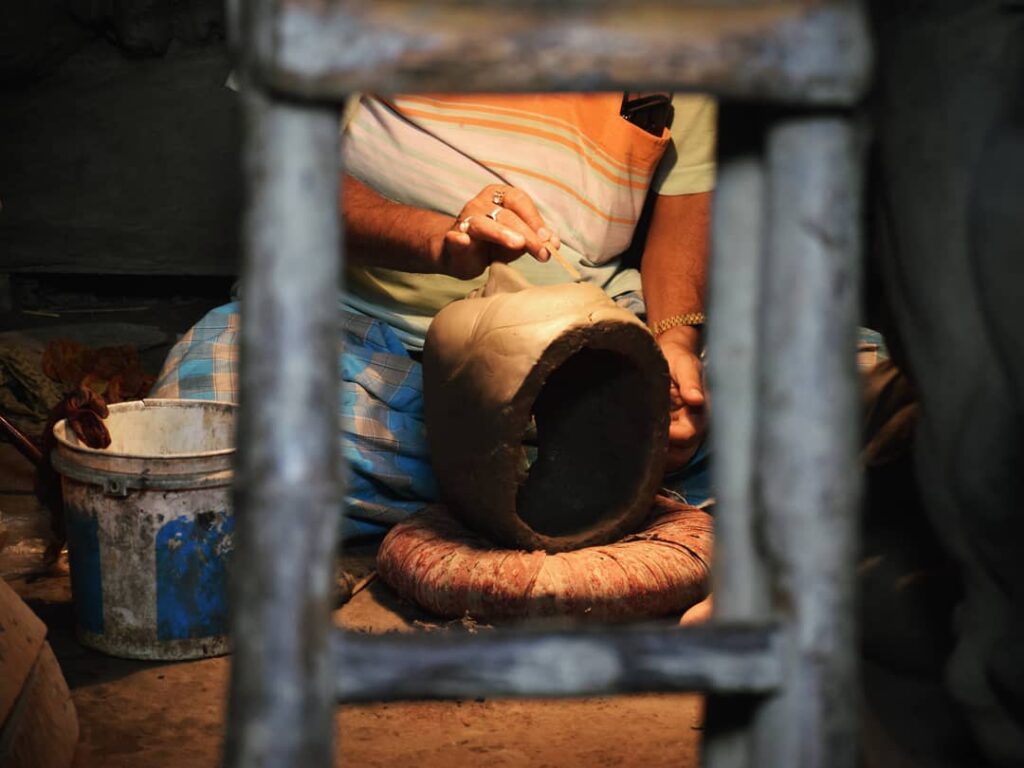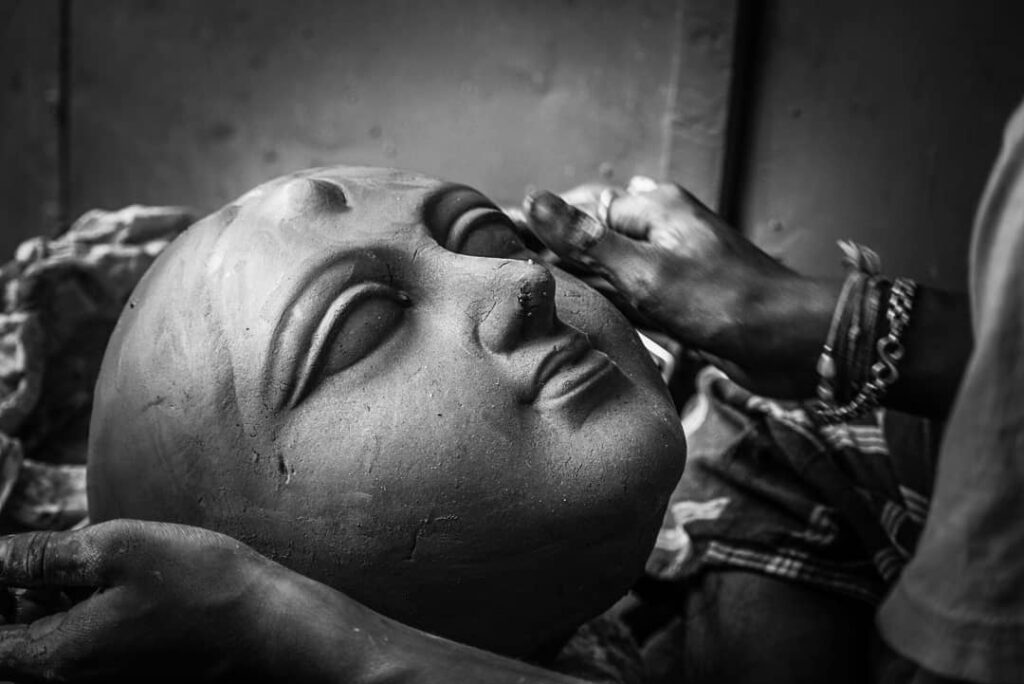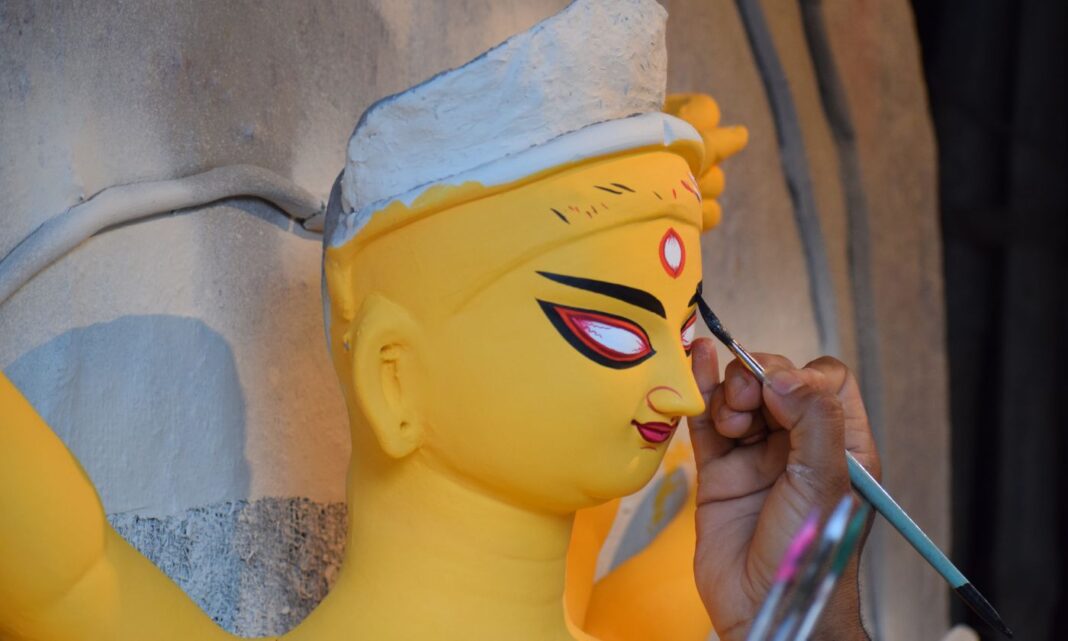Kumartuli, a small locality in Kolkata meaning potter’s village.
Ever since childhood I visited this place only once a year, during Durga Puja, when we went to Kumartuli Park and Kumartuli Sarbojonin. While hopping between these pandals, we would pass through Kumartuli.
As we walked by, my uncle would point out the potters busy crafting Lakshmi idols. Why did I specifically mention Lakshmi?
Because in Bengal, Lakhi Puja takes place right after Durga Puja.
But those were my childhood days. As I grew up, I kept hearing more about this place, and as an enthusiastic pandal hopper with a deep interest in Durga Puja, I became really excited to see and learn how Maa Durga idols are made.
So one fine day I packed my camera and set out to explore. This is where you truly understand the hardships artisans face while creating idols, from collecting clay to shaping it and finally painting it. All this hard work is for just five days of Puja.
Alongside the artisans, you will also find a bunch of photographers like me, busy trying to capture those beautiful moments. You can experience all this when you visit Kumartuli. But Kumartuli is not just about what you see today. It has a story of its own, about how this place came to be, its origin, and some really interesting tales.
Story of Kumartuli.
Kumartuli, as we know it, is the potters’ locality in Kolkata. Every year, just before Durga Puja, people gather here to witness the creation of Goddess Durga. And these days, it has also become a favorite spot for photoshoots, perhaps even more than before.
The Origins – Potters Become Sculptors
The story of Durga Puja in Bengal is as old as the land itself. It’s layered with history, folklore, and politics.
The first grand worship of Goddess Durga in recorded history is said to date back to the late 1500s, when zamindars of Dinajpur and Malda celebrated the festival in their estates.
Another tale credits Raja Kangshanarayan of Taherpur or Bhabananda Mazumdar of Nadia with organizing the first Sharadiya Puja around 1606.
However in the 1700s, the small town of Krishna Nagar started getting fame for bringing Maa Durga’s idol to life for the Nadia Raj family of Maharaja Krishna Chandra Ray.
Kolkata as some claim already existed before the British East India company started creating it, it was Kalikhetra, the land of Kali.
The East India Company finally chose to create a settlement by the banks of river Hoogly.
As they started shaping the city, they started organizing the city based on trades, and in this process potters were allotted a place in an area near Shobhabazar, which is known as Kumartuli.
The potters did settle, but they were no idol-makers. Then their livelihood used to depend on other items, like clay pots and utensils.
They were from Kishnagar and as mentioned were known for clay works. The river Hooghly gave them the right clay; the growing colonial city gave them a bustling market.
But what truly changed their destiny was a puja.
A Turning Point – The Puja of 1757
In the year 1757, Raja Nabakrishna Deb of Sovabazar organized a grand Durga Puja at his mansion. It was partly to honor Robert Clive, partly to display the wealth and power of the new Bengali elite who had prospered under Company patronage.
For this puja, he needed skilled idol-makers and so he brought some of the finest artisans from Krishnanagar. Many of them stayed back. But why??
It is because, gradually the popularity of organising Durga puja started growing particularly among the Bengali Aristocratic family, the Zamindars.
As a result, orders multiplied, and slowly, the settlement of Kumartuli transformed from a colony of potters into a workshop of gods.
Gradually as the time progressed, the potters of Kumartuli perfected their art.
What some say began as clay vessels became lifelike Durga idols, crafted with straw frames, river clay, and a painter’s devotion.
Every year, the lanes filled with half-finished forms of Ma Durga, waiting for Chokkhu Daan; the moment when her eyes were painted, and she came alive.
The location was perfect: soft alluvial clay from the Hooghly, easy transport for idols by boat, and wealthy patrons nearby. Kumartuli became indispensable to Kolkata’s Puja culture.
Evolution of Durga Puja – Changing from Ekchala to Panch Chala
By the 19th century, idol-making had almost replaced pottery as the main livelihood.
Then came a moment of crisis that would change Kumartuli forever. In 1938, just before the Puja, a fire broke out at the Kumartuli Sarbojanin Durga Puja.
The idols were reduced to ash, and panic spread, how could the festival go on with so little time left?
It was here that Netaji Subhas Chandra Bose, then the president of the Puja committee, stepped in. Refusing to give up, he turned to the sculptors of Kumartuli.
Among them was the brilliant artist Gopeshwar Pal, recently back from Italy. Faced with impossible deadlines, Gopeshwar Pal improvised.Instead of the traditional ekchala idol (all deities in a single frame), he created the goddess and her children in five separate frames, the Panchchala design.
Obviously people were not happy with it, however Netaji Subhas Bose handled the situation, some said he humorously said that its better for children to stay away when their mother is fighting with the asura.
This allowed multiple artisans to work simultaneously, speeding up construction. The idols were ready in time, the Puja was saved, and the innovation soon became the new standard across Bengal.
What had begun as a desperate solution in the ashes of a fire became a symbol of Kumartuli’s adaptability.
In the late 20th century, as Kolkata’s pujas turned thematic, Kumartuli’s artists adapted, blending tradition with imagination, from classical clay idols to experimental, eco-friendly, and globally admired designs..
Today’s Kumartuli



Today you’ll find Kumartuli alive, like a breathing canvas.
When you walk through its narrow lanes, clay dust hangs in the air. Unfinished faces of gods and goddesses stare at you from every corner, as if waiting for that first stroke of a brush to open their eyes.
Here, artistry is not hidden away in galleries. It spills onto the streets. You can smell the clay, watch the artisans at work, and witness how each idol slowly comes alive.
Durga Puja is the grandest festival for Bengalis, and in 2021 UNESCO recognized it as an Intangible Cultural Heritage of Humanity. Every year, as autumn arrives, Kumartuli turns into a workshop of miracles. From towering Durga idols that dominate Kolkata’s pandals to carefully packed clay deities sent across the seas to London, Toronto, or New Jersey, the creations of Kumartuli now travel far beyond Bengal.
The same hands that once shaped simple pots now give form to gods who carry the spirit of Durga Puja across the world.
How to Reach Kumartuli?
So, if you’re planning to visit Kumartuli, let me tell you, it’s not hard to find, particularly when everyone carries a smart phone and knows how to use Google maps.
The simplest way?
You can book a cab. But if you don’t want to spend much and avoid the traffic, then we have Kolkata metro, the oldest in India.
Take the metro. Just get down at Shobhabazar Sutanuti station. From there it’s a ten-minute walk through the lanes of Kolkata. Just as you reach Rabindra Sarani, you can ask a local tea stall about the location, and he will happily guide you.
If you’re in no hurry and want to soak in a bit of nostalgia, hop on a bus along Rabindra Sarani.
And if you want something really special, you can take the ferry. Cross the Hooghly, get down at Bagbazar ghat, and walk into Kumartuli with the river breeze on your face. That’s when you really feel how close this art is to the Ganga’s clay.
But here’s a tip, the best time to go is in the weeks before Durga Puja. That’s when the lanes are buzzing, idols are drying under the sun, and trucks are lining up to carry them off to pandals or even airports. Visit then, and you’ll see Kumartuli at its most alive.
Summing Up.
Kumartuli is more than just an “idol factory.” It is a heritage neighborhood, where tradition and innovation co-exist. Some artisans still swear by the old ekchala idols, preserving the simplicity of centuries past. Others experiment with fiberglass, eco-friendly clay, or themed artistry that reflects modern times.
From fictional grandeur to climate-change awareness, Kumartuli’s idols now carry stories as diverse as the city itself.
But step inside one of the dimly lit studios, and you realise that what hasn’t changed is the devotion. The same river clay from the Hooghly, the same rituals before starting work, the same faith that from lifeless earth, divinity will rise again.
Kumartuli, even today, is not just about making idols; it is about shaping belief, year after year.
And once these idols leave the studios, they bring the magic of Kumartuli to life across Kolkata. From the bustling streets to grand pandals, every Durga Puja in the city becomes a vibrant celebration, a glimpse of which captures the soul of Bengal itself.
![]()

